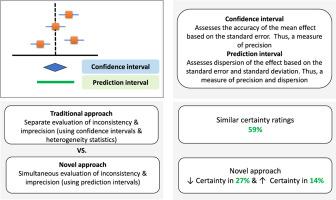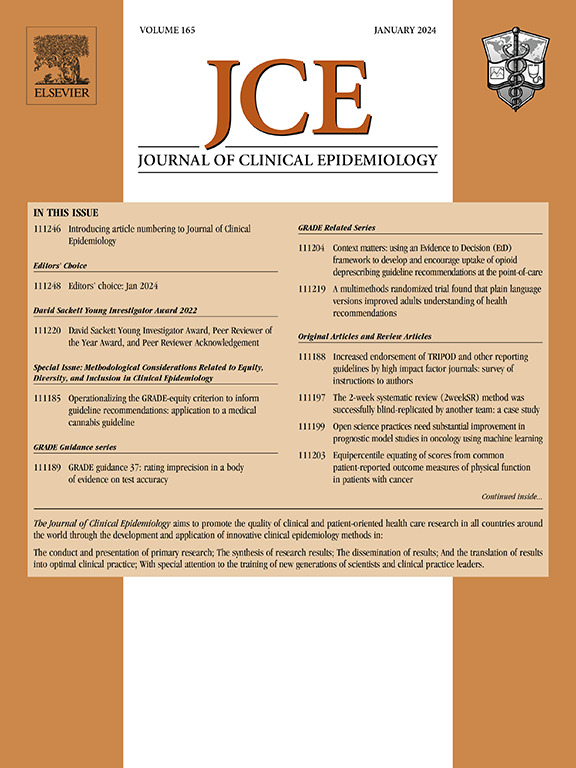Simultaneous evaluation of the imprecision and inconsistency domains of GRADE can be performed using prediction intervals
IF 7.3
2区 医学
Q1 HEALTH CARE SCIENCES & SERVICES
引用次数: 0
Abstract
Objectives
To explore the use of prediction interval (PI) for the simultaneous evaluation of the imprecision and inconsistency domains of Grading of Recommendations, Assessment, and Evaluation using stakeholder-provided decision thresholds.
Study Design and Setting
We propose transforming the PI of a meta-analysis from a relative risk scale to an absolute risk difference using an appropriate baseline risk. The transformed PI is compared to stakeholder-provided thresholds on an absolute scale. We applied this approach to a large convenience sample of meta-analyses extracted from the Cochrane Database of Systematic Reviews and compared it against the traditional approach of rating imprecision and inconsistency separately using confidence intervals and statistical measures of heterogeneity, respectively. We used empirically derived thresholds following Grading of Recommendations, Assessment, and Evaluation guidance.
Results
The convenience sample consisted of 2516 meta-analyses (median of 7 studies per meta-analysis; interquartile range: 5–11). The main analysis showed the percentage of meta-analyses in which both approaches had the same number of certainty levels rated down was 59%. The PI approach led to more levels of rating down (lower certainty) in 27% and to fewer levels of rating down (higher certainty) in 14%. Multiple sensitivity analyses using different thresholds showed similar results, but the PI approach had particularly increased width with a larger number of included studies and higher I2 values.
Conclusion
Using the PI for simultaneous evaluation of imprecision and inconsistency seems feasible and logical but can lead to lower certainty ratings. The PI-based approach requires further testing in future systematic reviews and guidelines using context-specific thresholds and evidence-to-decision criteria.
Plain Language Summary
The prediction interval (PI) addresses both the imprecision and inconsistency domains of certainty. In this study, we applied this PI approach to simultaneously judge both domains and compared this to the traditional approach of making these separate judgments. The 2 approaches had moderate agreement. The PI-based approach requires further testing in future systematic reviews and guidelines using context-specific thresholds and evidence-to-decision criteria.

使用预测区间可同时评估 GRADE 的不精确性和不一致性领域。
目的:探索使用预测区间(PI)同时评估 GRADE 的不精确性和不一致性:利用利益相关者提供的决策阈值,探索如何使用预测区间(PI)同时评估 GRADE 的不精确性和不一致性:我们建议使用适当的基线风险将荟萃分析的预测区间从相对风险表转换为绝对风险差。将转换后的 PI 与利益相关者提供的绝对阈值进行比较。我们将这种方法应用于从 Cochrane 系统性综述数据库中提取的大量荟萃分析样本,并将其与分别使用置信区间和异质性统计量对不精确性和不一致性进行评级的传统方法进行了比较。我们按照 GRADE 指南使用了根据经验得出的阈值:方便样本包括 2,516 项元分析(每项元分析的中位数为 7 项研究,四分位数区间为 5-11 项)。主要分析结果表明,在两种方法中,确定性等级下调数量相同的荟萃分析占 59%。PI 方法导致更多等级下调(确定性较低)的占 27%,而导致更少等级下调(确定性较高)的占 14%。使用不同阈值进行的多重敏感性分析显示了相似的结果,但如果纳入的研究数量较多,I2 值较高,PI 方法的宽度尤其会增加:结论:使用 PI 同时评估不精确性和不一致性似乎可行且合乎逻辑,但会导致确定性评级降低。基于 PI 的方法需要在未来的系统综述和指南中使用特定的阈值和证据决定标准进行进一步测试。
本文章由计算机程序翻译,如有差异,请以英文原文为准。
求助全文
约1分钟内获得全文
求助全文
来源期刊

Journal of Clinical Epidemiology
医学-公共卫生、环境卫生与职业卫生
CiteScore
12.00
自引率
6.90%
发文量
320
审稿时长
44 days
期刊介绍:
The Journal of Clinical Epidemiology strives to enhance the quality of clinical and patient-oriented healthcare research by advancing and applying innovative methods in conducting, presenting, synthesizing, disseminating, and translating research results into optimal clinical practice. Special emphasis is placed on training new generations of scientists and clinical practice leaders.
 求助内容:
求助内容: 应助结果提醒方式:
应助结果提醒方式:


